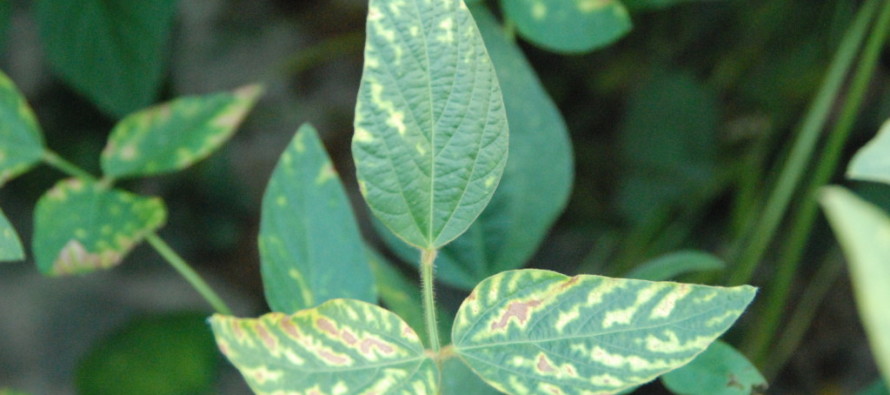Diagnosing Fungicide Phytotoxicity and Telling Apart from Root Diseases

Related Articles
- 2010 Soybean And Corn Variety Trial Data 3
- Rice Variety Trial Results For 2010, Plus Rice Research Report 0
- Evaluation of Peanut Prescription Rx Program in Mississippi 0
Latest Tweets

The phytotoxicity associated with the application of some fungicide products can produce an observable interveinal chlorosis.
Once again, foliar fungicide phytotoxicity has been observed throughout the Mississippi soybean production system as a result of applying certain products. In some cases, and this year in particular, some of the symptoms associated with the “injury” appear to be more severe than in the recent past. However, trials conducted over the past several seasons in Starkville as well as Stoneville have attempted to determine whether a yield loss is associated with the observable symptoms. At present, and based on trial data from 2012 to 2014, a yield loss is not associated with the symptoms presented. For additional information see:
Observational similarities to root diseases
Much of the time the symptoms associated with phytotoxicitiy are confused with sudden death syndrome (SDS). The interveinal chlorosis that results due to SDS does in fact look quite similar. However, SDS has traditionally been observed in light soil classes. Fields that contain soil classes that include high concentrations of clay have not been historically affected by SDS in the MS soybean production system. However, in most cases, root diseases will affect the vascular plant tissues. Cutting the main stem and exposing the vascular tissues inside the soybean stem can help diagnose the field situation. In addition, most root diseases occur in a small area. Large areas of a single field or multiple fields affected by something that appears to be a disease should be observed repeatedly to determine the cause. Pull up plants from affected areas to determine whether or not a root disease is occurring versus injury following a fungicide application.
Products responsible for phytotoxicity
Historically, tebuconazole was the fungicide responsible for producing phytotoxicity. In fact, the symptoms associated with phytotoxicity have historically been referred to as “tebuconazole phytotoxicity” since the injury was indicative of a fungicide application with Folicur (no longer available). Presently, several products can result in the production of phytotoxicity. Some of those products do in fact contain tebuconazole as one of the main ingredients (Fungicide phytotoxicity products); however, several additional active ingredients can result in a mild, to moderate, to severe phytotoxicity response. For example, several years ago metconazole (Caramba) was labeled for use in soybean to manage soybean rust. The active ingredient is also one of the components in Headline AMP (pyraclostrobin + metconazole). But, following field trials with the products that included moderate to severe phytotoxicity, BASF removed the soybean label for the two products.
Over the past three seasons, the response of soybean plants has been assessed in treated plots to determine the presence of phytotoxicity in addition to the efficacy of products on foliar diseases. The response of soybean plants was assessed similar to disease; however, phytotoxicity was assessed using a scale of 0 to 100%. For the purposes of presentation the response has been broken down to a scale of 0 to 9 whereby 0=no phytotoxicity and 9=severe phytotoxicity (Fungicide phytotoxicity rankings). The 0 to 9 scale was then broken down into a mild (1-2), moderate (3-4) and severe ranking (5+) based on the level of foliage affected by the fungicide.
Plant disease symptoms similar to phytotoxicity
Numerous plant diseases can produce an interveinal chlorosis similar to the chlorosis observed as a result of fungicide phytotoxicity. For more specific information regarding some of these diseases refer to: https://www.mississippi-crops.com/2013/08/09/not-everything-is-as-it-seems-fungicide-phytotoxicity-and-plant-diseases/

The canker associated with stem canker can occur on the main stem or at the point where a stem branching occurs.
-stem canker – can produce a foliar symptom similar to phytotoxicity with interveinal necrosis. However, presence of the canker will be identified on the main stem and by cutting into the pith the vascular tissue will generally be stained and light brown to brown in coloration. In addition, unless the soybean variety is extremely susceptible, the number of plants affected will occur in a small clump.

Sudden death syndrome will generally occur in a small area of affected plants within a field situation. Interveinal chlorisis can be observed to be similar to the injury associated with fungicide phytotoxicity.
-SDS – similar to the above information regarding stem canker, interveinal necrosis can also be observed as a result of SDS. Small clumps of plants, unless the soybean cyst nematode (SCN) are present in large numbers within a field that contains light soil classes.

Red crown rot produces interveinal chlorosis similar to SDS, additional diseases, as well as phytotoxicity. However, the affected area will generally be quite small.

Vascular staining will be associated with red crown rot in addition to the production of red fungal structures at the base of the stem.
-red crown rot – as outlined above, the symptoms associated with red crown rot are similar in the production of interveinal chlorosis in the foliage. However, while a vascular staining can accompany red crown rot the growth of red fungal structures on the main stem at the base of the soil line should be the most diagnostic feature associated with this disease.








Let me tell You a sad story ! There are no comments yet, but You can be first one to comment this article.
Write a comment